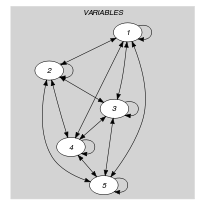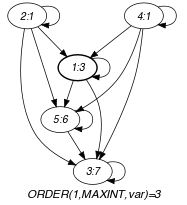5.256. min_n
| DESCRIPTION | LINKS | GRAPH | AUTOMATON |
- Origin
- Constraint
- Arguments
- Restrictions
- Purpose
is the minimum value of rank (i.e., the smallest distinct value, identical values are merged) of the collection of domain variables . The minimum value has rank 0.
- Example
-
The constraint holds since its first argument is fixed to the second (i.e., ) smallest distinct value of the collection . Note that identical values are only counted once: this is why the minimum of order 1 is 3 instead of 1.
- Typical
- Symmetries
Items of are permutable.
One and the same constant can be added to as well as to the attribute of all items of .
- Arg. properties
Functional dependency: determined by and .
- Algorithm
- Reformulation
The constraint enforces to be assigned one of the values of . The constraint provides a hand on the number of distinct values assigned to the variables of . By associating to each variable of the collection a rank variable with the reified constraint , the inequality , and by creating for each pair of variables the reified constraints
,
,
,
one can reformulate the constraint in term of reified constraints.
- See also
-
generalisation: (absolute minimum replaced by minimum or order ).
- Keywords
characteristic of a constraint: rank, minimum, maxint, automaton, automaton with array of counters.
constraint arguments: pure functional dependency.
- Cond. implications
- Arc input(s)
- Arc generator
-
- Arc arity
- Arc constraint(s)
- Graph property(ies)
-
- Graph model
Parts (A) and (B) of Figure 5.256.1 respectively show the initial and final graph associated with the Example slot. Since we use the graph property, the vertex of rank 1 (without considering the loops) of the final graph is shown in grey.
Figure 5.256.1. Initial and final graph of the constraint


(a) (b)
